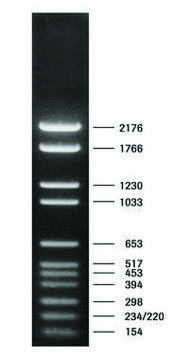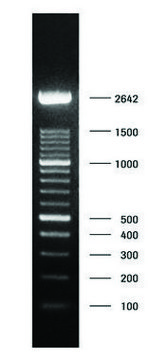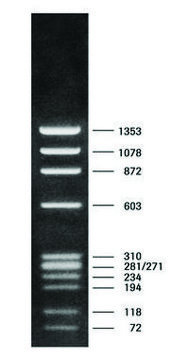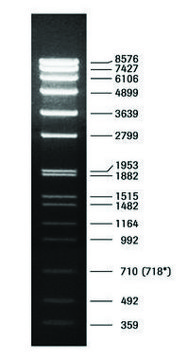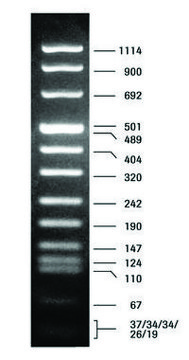10236250001
Roche
DNA Molecular Weight Marker II
Synonym(s):
DNA marker
Sign Into View Organizational & Contract Pricing
All Photos(1)
About This Item
UNSPSC Code:
41105335
Recommended Products
form
solution
packaging
pkg of 50 μg (in 200 μl)
manufacturer/tradename
Roche
storage condition
avoid repeated freeze/thaw cycles
General description
DNA Molecular Weight Marker II is a ready-to-use solution, 250μg/ml, in TE buffer (Tris-HCl, 1mM EDTA, pH 8.0). The bacteriophage λ DNA is fragmented in a restriction digestion with Hind III endonuclease. The digestion reaction results in eight double-stranded DNA fragments with the following base pair lengths (1 base pair = 660 Daltons): 125, 564, 2027, 2322, 4361, 6557, 9416, and 23130. The fragments have 5′-protruding ends and can be labeled with radioactive nucleotides (e.g., [32P]-dTTP or [32P]-dGTP) by standard filling-in reactions. End-labeling reactions can be performed with a radioactive or nonradioactive dideoxynucleotide (e.g., DIG-11-ddUTP) and Terminal Transferase. The product is also available as DNA Molecular Weight Marker II, Digoxigenin-labeled.
The High Fidelity PCR Master is a ready-to-use, double-concentrated master mix that contains all the reagents (PCR-Grade dNTPs, MgCl2, and an optimized reaction buffer) required to perform PCR (except template and primer). PCR grade water is also supplied.
The special enzyme blend is composed of two thermostable polymerases: Taq DNA Polymerase and a thermostable polymerase with proofreading activity. The 5′→3′ polymerase activity of Taq DNA Polymerase and the 3′→5′ exonuclease of the proofreading polymerase combine for improved performance. It gives PCR products with high yield, high fidelity, and high specificity from episomal and genomic DNA. Due to the inherent 3′→5′ exonuclease activity of the proofreading polymerase, the High Fidelity PCR Master results in approximately three times the fidelity and approximately twice the yield of Taq DNA Polymerase alone. The product is ideal for blunt end cloning or T/A cloning. It can amplify longer fragments (up to 5kb) with high fidelity and also minimize contamination with the help of two pipetting steps.
The special enzyme blend is composed of two thermostable polymerases: Taq DNA Polymerase and a thermostable polymerase with proofreading activity. The 5′→3′ polymerase activity of Taq DNA Polymerase and the 3′→5′ exonuclease of the proofreading polymerase combine for improved performance. It gives PCR products with high yield, high fidelity, and high specificity from episomal and genomic DNA. Due to the inherent 3′→5′ exonuclease activity of the proofreading polymerase, the High Fidelity PCR Master results in approximately three times the fidelity and approximately twice the yield of Taq DNA Polymerase alone. The product is ideal for blunt end cloning or T/A cloning. It can amplify longer fragments (up to 5kb) with high fidelity and also minimize contamination with the help of two pipetting steps.
Application
DNA Molecular Weight Marker II provides accurate sizing of fragments over a broad range of sizes. It is used as a DNA Molecular Weight Marker for agarose gels and simplifies accurate molecular weight determination of double-stranded DNA fragments generated by:
- Restriction digests
- PCR
- RT-PCR
DNA Molecular Weight Marker II provides accurate sizing of fragments over a broad range of sizes. The fragments have 5′-protruding ends and can be labeled with radioactive nucleotides (e.g. [32P]-dTTP or [32P]-dGTP) by standard filling-in reactions. End-labeling reactions can be performed with a radioactive or nonradioactive dideoxynucleotide (e.g., DIG-11-ddUTP) and Terminal Transferase.
DNA Molecular Weight Marker for agarose gels; simplifies accurate molecular weight determination of double-stranded DNA fragments generated by:
DNA Molecular Weight Marker for agarose gels; simplifies accurate molecular weight determination of double-stranded DNA fragments generated by:
- Restriction digests
- PCR
- RT-PCR
DNA molecular weight marker II has been used to estimate the nucleic acid concentrations corresponding to the intensities of fluorescence obtained.
The High Fidelity PCR Master is used for:
- PCR up to 5kb
- RT-PCR up to 5kb
Features and Benefits
The High Fidelity PCR Master reduces the setup time and can be immediately used without thawing.
Sequence
The bacteriophage lambda (λ) DNA is fragmented in a restriction digestion with Hind III endonuclease. The digestion reaction results in eight double-stranded DNA fragments with the following base pair lengths (1 base pair = 660 Daltons): 125, 564, 2027, 2322, 4361, 6557, 9416, and 23130.
Note: Fragment lengths are derived from computer analysis of the DNA sequence. Depending on the size range of the marker, the smallest fragments will only be visible on overloaded gels.
Note: Fragment lengths are derived from computer analysis of the DNA sequence. Depending on the size range of the marker, the smallest fragments will only be visible on overloaded gels.
Unit Definition
50 μg = 1A260 unit
Preparation Note
Storage conditions (working solution): 2 to 8 °C
Once thawed store at 2 to 8 °C.
Once thawed store at 2 to 8 °C.
Storage and Stability
Store at -15–-25 °C. (unopened vial)
Other Notes
Fragment lengths are derived from computer analysis of the DNA sequence. Depending on the size range of the marker, the smallest fragments will only be visible on overloaded gels.
For life science research only. Not for use in diagnostic procedures.
For life science research only. Not for use in diagnostic procedures.
Storage Class Code
12 - Non Combustible Liquids
WGK
nwg
Flash Point(F)
does not flash
Flash Point(C)
does not flash
Regulatory Information
常规特殊物品
Choose from one of the most recent versions:
Already Own This Product?
Find documentation for the products that you have recently purchased in the Document Library.
Raquel Martín-Hernández et al.
Applied and environmental microbiology, 73(20), 6331-6338 (2007-08-07)
A multiplex PCR-based method, in which two small-subunit rRNA regions are simultaneously amplified in a single reaction, was designed for parallel detection of honeybee microsporidians (Nosema apis and Nosema ceranae). Each of two pairs of primers exclusively amplified the 16S
S Nabian et al.
Iranian journal of parasitology, 6(3), 89-95 (2012-02-22)
Nosemosis of European honey bee (Apis mellifera) is present in bee colonies worldwide. Until recently, Nosema apis had been regarded as the causative agent of the disease, that causes heavy economic losses in apicultures. Nosema ceranae is an emerging microsporidian
Eating or being eaten: factors that determine the nutritional status of larvae of Engraulis anchoita of the Patagonian population of the species
Diaz M,et al.
Ecologia Austral, 26 (2016)
Ali Naini et al.
Methods in cell biology, 155, 383-400 (2020-03-19)
The maternally inherited mitochondrial DNA (mtDNA) is a circular 16,569bp double stranded DNA that encodes 37 genes, 24 of which (2 rRNAs and 22 tRNAs) are necessary for transcription and translation of 13 polypeptides that are all subunits of respiratory
Our team of scientists has experience in all areas of research including Life Science, Material Science, Chemical Synthesis, Chromatography, Analytical and many others.
Contact Technical Service
